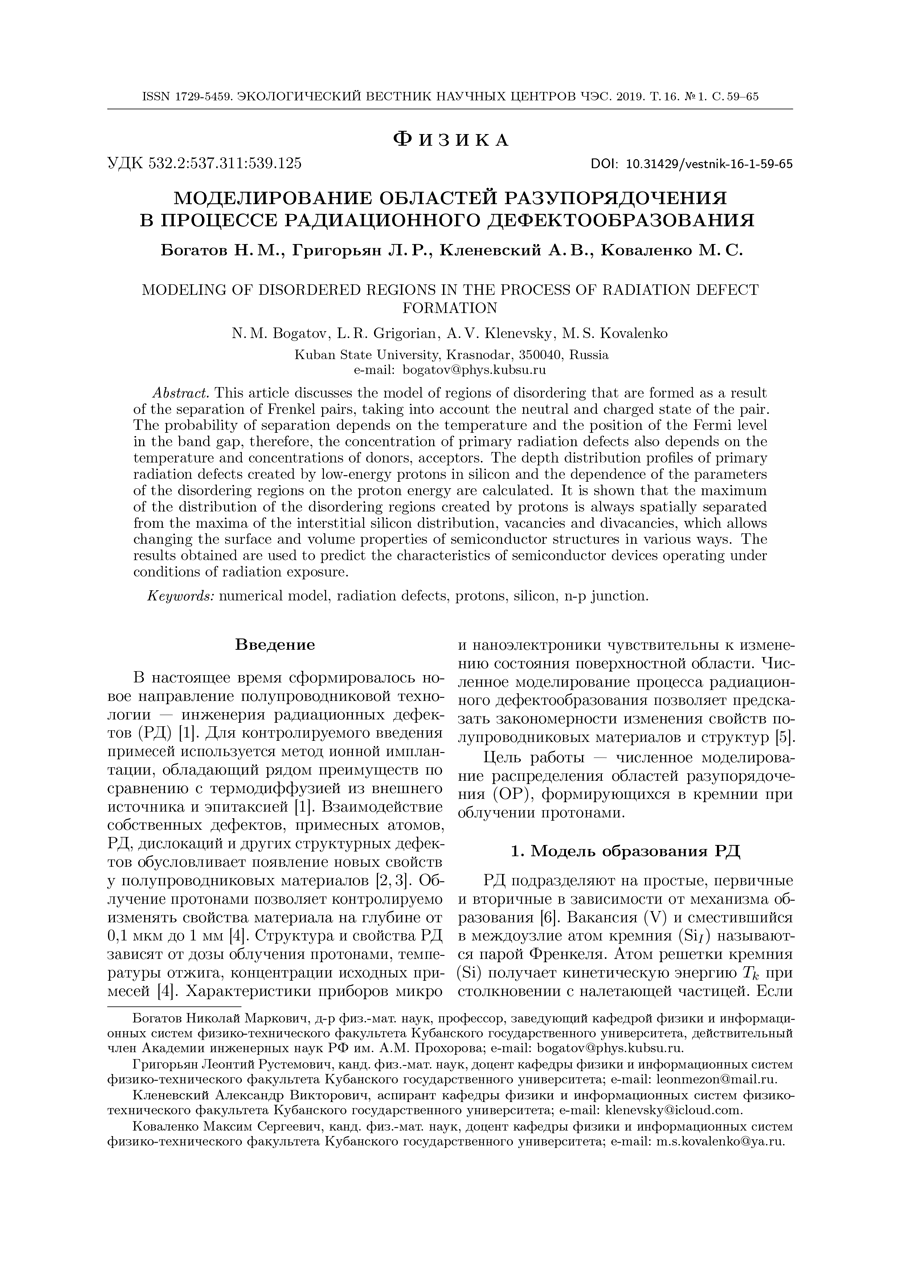Modeling of disordered regions in the process of radiation defect formation
UDC
532.2:537.311:539.125DOI:
https://doi.org/10.31429/vestnik-16-1-59-65Abstract
This article discusses the model of regions of disordering that are formed as a result of the separation of Frenkel pairs, taking into account the neutral and charged state of the pair. The probability of separation depends on the temperature and the position of the Fermi level in the band gap, therefore, the concentration of primary radiation defects also depends on the temperature and concentrations of donors, acceptors. The depth distribution profiles of primary radiation defects created by low-energy protons in silicon and the dependence of the parameters of the disordering regions on the proton energy are calculated. It is shown that the maximum of the distribution of the disordering regions created by protons is always spatially separated from the maxima of the interstitial silicon distribution, vacancies and divacancies, which allows changing the surface and volume properties of semiconductor structures in various ways. The results obtained are used to predict the characteristics of semiconductor devices operating under conditions of radiation exposure.
Keywords:
numerical model, radiation defects, protons, silicon, n-p junctionReferences
- Chelyadinsky, A., Komarov, F. Defektno-primesnaya inzheneriya v implantirovannom kremnii [Defect-impurity engineering in implanted silicon]. Uspekhi Fizicheskikh Nauk [Physics-Uspekhi], 2003, vol. 173, no. 8, pp. 813–846. (In Russian)
- Brudny, V.N. Radiatsionnyye effekty v poluprovodnikakh [Radiation effects in semiconductors]. Vestnik Tomskogo gosudarstvennogo universiteta [Tomsk State University Bulletin], 2005, no. 285: Series "Physics", pp. 95–102. (In Russian)
- Sobolev, N.A. Inzheneriya defektov v implantatsionnoy tekhnologii kremniyevykh svetoizluchayushchikh struktur s dislokatsionnoy lyuminestsentsiyey [Defect engineering in implantation technology of silicon light-emitting structures with dislocation luminescence]. Fizika i tekhnika poluprovodnikov [Physics and technology of semiconductors], 2010, vol. 44, no. 1, pp. 3–25. (In Russian)
- Kozlov, V.A., Kozlovsky, V.V. Legirovaniye poluprovodnikov radiatsionnymi defektami pri obluchenii protonami i α-chastitsami [Doping of semiconductors with radiation defects when irradiated with protons and α-particles]. Fizika i tekhnika poluprovodnikov [Physics and technology of semiconductors], 2001, vol. 35, no. 7, pp. 769–795. (In Russian)
- Agafonov, Y.A., Bogatov, N.M., Grigorian, L.R., Zinenko V.I., Kovalenko A.I., Kovalenko M.S., Kolokolov F.A. Effect of Radiation-Induced Defects Produced by Low-Energy Protons in a Heavily Doped Layer on the Characteristics of n+-p-p+ Si Structures. Journal of Surface Investigation: X-ray, Synchrotron and Neutron Techniques, 2018, vol. 12, no. 3, pp. 499–503.
- Vavilov, V.S., Kiselev, V.F., Mukashev, B.N. Defekty v kremnii i na yego poverkhnosti [Defects in silicon and on its surface]. Moscow, Nauka, 1990. (In Russian)
- Kinchin, G.Kh., Pease, R.S. Smeshcheniye atomov tverdykh tel pod deystviyem izlucheniya [Displacement of atoms of solids under the action of radiation]. Uspekhi Fizicheskikh Nauk [Physics-Uspekhi], 1956, vol. 60, no. 4, pp. 590–615. (In Russian)
- Lindhard, J. Nielson, V., Scharff, M., Thomson P.V. Integral equations covering radiation effects notes an atomic collision II. Kgl. Danske Vid. Selsk. Mat. Fys. Medd, 1963, vol. 33, no. 10, pp. 14–42.
- Kuznetsov, N.V., Soloviev, G.G. Radiatsionnaya stoykost' kremniya [Radiation resistance of silicon]. Moscow, Energoatomizdat, 1989. (In Russian)
- Bogatov, N.M., Kovalenko, M.S. Calculation of Frenkel Pairs Separation, Formed in Silicon as a Result of Ionizing Particles Irradiation. AASCIT Journal of Physics, 2017, vol. 3. no. 3, pp. 13–17.
- Bogatov, N.M. Radiation defects in silicon grown by the Czochralski method. Surface Investigation X-Ray, Synchrotron and Neutron Techniques, 1999, vol. 15, no. 3, pp. 561–571.
- Vavilov, V.S., Kiv, A.E., Niyazova, O.R. Mekhanizmy obrazovaniya i migratsii defektov v poluprovodnikakh [Mechanisms of formation and migration of defects in semiconductors]. Moscow, Nauka, 1981. (In Russian)
- Van Lint, V.A., Leadon, R.E., Colwell, J.F. Energy dependence of displacement effects in semiconductors. IEEE Trans. of Nucl. Sci., 1972. vol. NS-19, no. 6, pp. 181–185.
- Van Lint, V.A., Leadon, R.E. Implications of cluster model of neutron effects in silicon. Lattice Defects in Semiconductors. Conf. 1974, London-Bristol. Institute of Physics, 1975, p. 227–232.
- Burenkov, A.F., Komarov, F.F., Kumakhov, M.A., Temkin M.M. Tablitsy parametrov prostranstvennogo raspredeleniya ionno-implantirovannykh primesey (teoriya, metod rascheta, tablitsy) [Tables of parameters of the spatial distribution of ion-implanted impurities (theory, calculation method, tables)]. Minsk, BSU, 1980. (In Russian)
Downloads
Submitted
Published
How to Cite
Copyright (c) 2019 Bogatov N.M., Grigorian L.R., Klenevsky A.V., Kovalenko M.S.

This work is licensed under a Creative Commons Attribution 4.0 International License.




